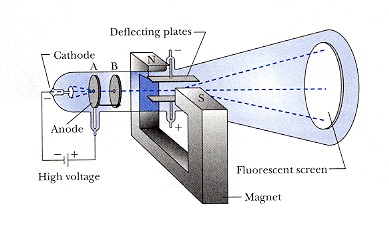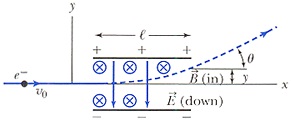Assignment:
Question 1. Across what potential difference does an electron have to be accelerated in order to reach the speed v = 9e7 m/s?
- Non-relativistically
- Relativistically
When should you use relativistic calculations?
Question 2. An electron entering Thomson's e/m apparatus (Figure 3.2 and 3.3) has an initial velocity (in horizontal direction only) of 0.7 107 m/s. Lying around the lab is a permanent horseshoe magnet of strength 1.3 10-2 T, which you would like to use.
(a) What electric field will you need in order to produce zero deflection of the electrons as they travel through the apparatus?
(b) When the magnetic field is turned off, but the same electric field remains, how large a deflection will occur if the region of nonzero E and B fields is 2 cm long?


Question 3. A photon of wavelength 2.2 nm Compton scatters from an electron at an angle of 90°. What is the modified wavelength? (Enter your answer correct to 5 significant figures.)
What is the percentage change?
Question 4. A photon having 27 keV scatters from a free electron at rest. What is the maximum energy that the electron can obtain?
Provide complete and step by step solution for the question and show calculations and use formulas.